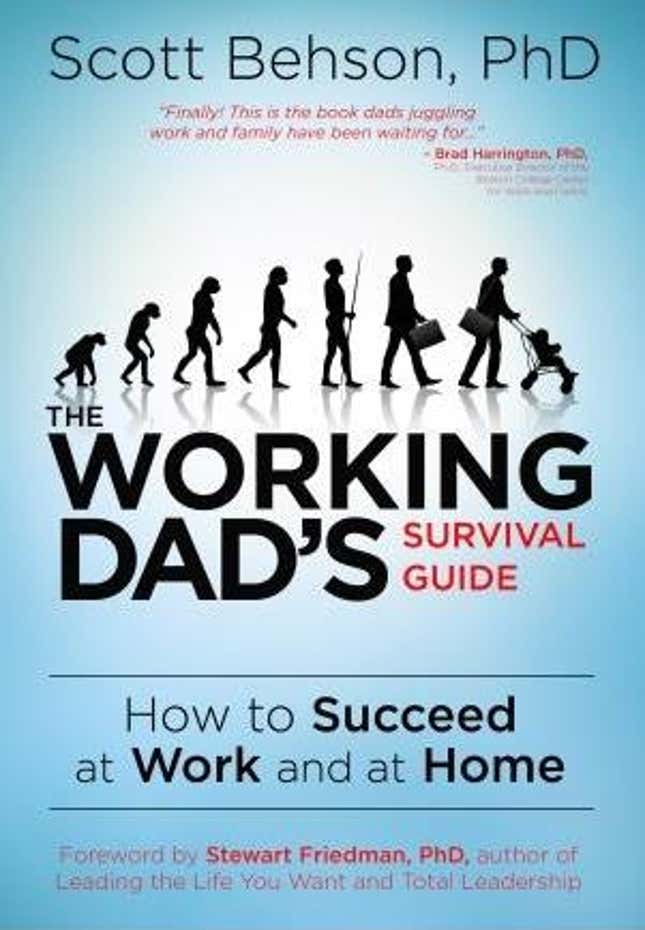In the process of researching my new book, The Working Dad’s Survival Guide: How to Succeed at Work at Home—a book of advice for dads who care both about their careers and being good fathers—I spoke with dozens of dads and studied employer and industry trends regarding work-family policy and paternity leave. I came away convinced that one of the best things Americans can do as a society, and as employers, is support working dads by providing paid paternity leave. Here are five reasons why, this Father’s Day, we should focus on giving dads around the country a gift they can truly use:
Paid paternity leave is needed
According to the International Labour Organization, out of 185 surveyed countries and territories, the US and Papua New Guinea are the only nations that do not provide paid maternity leave, and an estimated 79 countries provide for some kind of paternity leave (the compensation and duration varies widely.) Besides the shame factor, this lack of public policy means that in the US, dads are dependent on our employers for paternity leave.
Unfortunately, only about 14% of private employers in the US offer paid paternity leave, according to a 2014 survey by the Families and Work Institute. As a result, many new dads cobble together a week or even less of accumulated time off when their kids are born. White-collar dads can fall back on paid vacation, but for many working-class dads, time away from work is a financial risk for their families.
This represents an enormous missed opportunity for fathers to spend time bonding with and caring for their newborns—an opportunity that can yield benefits that last a lifetime.
Paid paternity leave is good for dads
I’m one of the lucky few dads who was able to take extended time away from work when my son was born, forging an immediate bond with my son, gaining confidence as a new parent, strengthening my relationship with my wife, and emerging from the experience as a fully involved co-parent and equal parenting partner. In short, during my paternity I was shaped as a person, parent, and spouse. And I believe it contributed to the strength and resiliency of my family. Even a few weeks can allow dads the chance to forge intimate lifelong relationships with their kids.
Research shows that involved fatherhood makes dads happier, healthier, more fulfilled, more successful at work, and even helps them live longer. Unlike those ugly slippers, paternity leave is a Father’s Day present that lasts a lifetime.
Paid paternity leave is good for families
Accumulating research demonstrates a clear link between paternity leave and subsequent paternal involvement and behaviors, including feeding, changing diapers, getting up during the night, bathing and reading to their children. There is also evidence that the children of fathers who take long leaves after their birth performed better on cognitive development tests and were more prepared as they entered school.
But the benefits don’t stop at childhood. There’s an entire library of research that shows that the benefits of having an involved father can last a lifetime. Kids with involved dads tend to stay in school and out of trouble. Girls with involved dads, meanwhile, are more likely to pursue a wider range of careers, including traditionally male-dominated ones, like engineering and science.
And then of course, there’s the most obvious benefit: Paternity leave is also great for moms. Involved dads share caregiving responsibilities, while allowing working women to return to the office sooner, if they wish to. Over time, this support releases moms from the (now outdated) expectation of having to be the “primary” parent.
Paternity leave is wanted
In many companies, particularly those with competitive “work before all” corporate cultures, it may not be safe for dads to “out themselves” as involved fathers by making use of paternity leave or other flexible work policies. This fear is borne out by research showing that men who visibly adjust their work around family concerns are often seen as less promotable and less manly, and can even risk workplace consequences and job insecurity. In fact, in researching my book, I interviewed several dads who did not use their available paternity leave policies for fear of reprisals, and one who did take an extended leave but, upon his return, was marginalized.
The good news is, these backwards attitudes are changing. A recent study from Boston College’s Center for Work and Family shows that, in companies that offered 2-4 weeks of paid paternity leave, a majority of dads took at least two weeks. Companies to continue to improve their corporate cultures so that working parents of both genders are supported.
Paternity leave is good for the bottom line
It seems paradoxical that paying people not to work would help a company’s bottom line. But in fact, offering programs like paternity leave does just that, because it allows companies to better attract and retain key talent, while keeping them more engaged and less burned out. This is especially true in industries where the talent pool is competitive.

In fact, 90% of working dads surveyed by Boston College stated that paternity leave is at least somewhat important when they evaluate potential employers (26% called it extremely important). shows that almost 80% of millennials say they’d be more likely to stay at a company that offered parental leave and flexibility.
Right now, offering paid paternity leave is a point of distinction in the war for talent. Over time, it will become a necessary benefit. Even now, there is a distinct trend of “industry tipping,” in which one firm offers paid paternity leave and its competitors quickly follow suit. For example, currently all “Big 4” global accounting firms offer generous leave, Silicon Valley firms keep one-upping each other, and even major investment banks like CitiGroup, Goldman Sachs, and Bank of America have expanded their paternity benefits.
This is not just a matter of retaining talented employees, however. The assessment of California’s paid parental leave insurance program (California is one of three states to offer paid parental leave) showed no evidence of negative impact on business. The report found 88% of firms saw either an increase or no change in performance over the first decade of the program, and many cited improved morale and engagement. Finally, we have evidence that the market responds favorably to companies that announce expanded leave policies, proving a significant stock price bump.
What else do you need to know? Paid paternity leave is the gift that keeps on giving—for fathers, mothers, children and even employers! And way better than yet another “World’s Best Dad” coffee mug.
Follow Scott on Twitter at @ScottBehson. We welcome your comments at ideas@qz.com.
